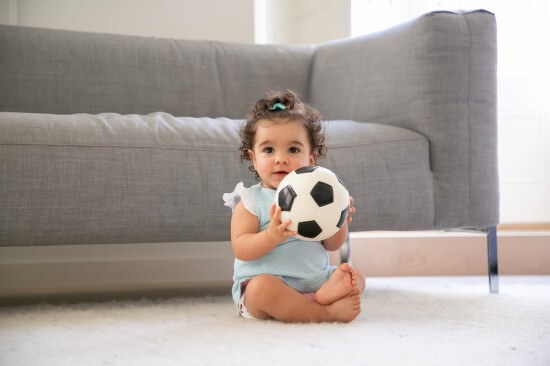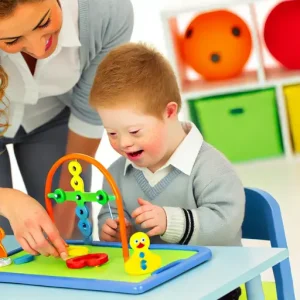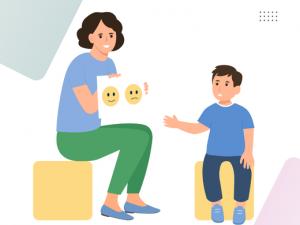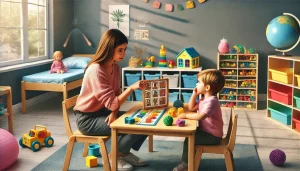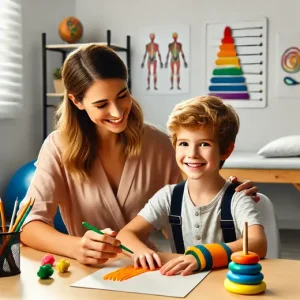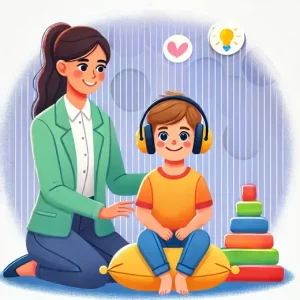Why Does a 2-Year-Old Need Occupational Therapy?
By Prapoorna M
Last Updated: July 12, 2024
Are you worried about your 2-year-old’s frequent tantrums or their struggle with daily activities like feeding themselves or getting dressed? If you find yourself asking, “Why does my 2-year-old need occupational therapy?” you’re not alone. Many parents share these concerns and wonder if their child’s development is on track.
Occupational therapy, often referred to as OT, is a specialized field that helps children develop the skills they need to perform everyday tasks. For young children, especially toddlers, this can be crucial in addressing various developmental delays and ensuring they can participate fully in daily activities.
Signs Your 2-Year-Old Might Need Occupational Therapy
As parents, it’s natural to worry about your child’s development and wonder, “Why do toddlers need occupational therapy?” or “What are the signs a 2-year-old needs occupational therapy?” Recognizing these signs early can make a significant difference in your child’s growth and daily functioning.
Frequent, Intense Tantrums
If your 2-year-old frequently has intense tantrums that seem more severe or last longer than those of other children their age, it might be a sign they need extra support. These meltdowns could be due to underlying sensory processing issues or difficulties in regulating their emotions, which occupational therapy can help address.
Also Read :When and Why a Child Needs Occupational Therapy
Difficulty Playing with New Toys
Another sign that your toddler might need occupational therapy is difficulty playing with new toys. Play is a crucial part of a child’s development, helping them learn about their environment and develop motor and cognitive skills. If your child seems uninterested or struggles to engage with new toys, it might indicate challenges with fine motor skills or sensory processing.
Struggles with Daily Activities and Self-Care Tasks
Everyday activities like feeding themselves, getting dressed, or brushing their teeth can be particularly challenging for some toddlers. If your child struggles with these self-care tasks, it may signal a need for occupational therapy. These difficulties can stem from problems with fine motor skills, coordination, or sensory sensitivities.
Examples of Self-Care Challenges:
- Feeding Themselves: Using utensils can be tough if your child has not yet developed the necessary fine motor skills.
- Dressing: Tasks like buttoning shirts or pulling up zippers require coordination and motor planning, which can be improved with occupational therapy.
How Occupational Therapy Can Help
If you’ve noticed signs that your child might need support, you might be wondering, “How can occupational therapy help my 2-year-old?” Occupational therapy, especially for toddlers, focuses on helping children develop the skills they need to perform everyday tasks.
Let’s explore the benefits of occupational therapy for 2-year-olds and how it can address various developmental challenges.
Addressing Gross Motor and Fine Motor Skills
One of the primary areas where 2-year-old occupational therapy can make a significant impact is in the development of gross motor and fine motor skills. Gross motor skills involve larger movements and muscle groups, such as walking, jumping, and running. Fine motor skills, on the other hand, involve smaller movements, particularly those of the hands and fingers, such as grasping small objects, holding utensils, and manipulating toys.
- Gross Motor Skills: Occupational therapists work on activities that improve your child’s balance, coordination, and strength. This might include climbing stairs, navigating playground equipment, and other activities that use large muscle groups.
- Fine Motor Skills: To enhance fine motor skills, therapists might engage your child in activities like coloring, building with blocks, or using scissors. These tasks help improve hand-eye coordination and dexterity, making daily tasks like feeding and dressing easier.
Sensory Processing Challenges
Many children face sensory processing challenges, which can make everyday experiences overwhelming or confusing. Occupational therapy helps children better process and respond to sensory information from their environment.
- Sensory Integration: Therapists use specific techniques and activities to help children become more comfortable with different textures, sounds, and movements. This can reduce sensory sensitivities and improve overall function.
- Emotional Regulation: By addressing sensory processing issues, occupational therapy also helps children manage their emotions better. This can lead to fewer meltdowns and more positive interactions with their environment and people around them.
Communication, Feeding, and Play Skills
Occupational therapy isn’t just about motor skills; it also plays a crucial role in enhancing communication, feeding, and play skills.
- Communication Skills: Through interactive play and targeted activities, therapists help children improve their ability to communicate their needs and interact with others. This can be particularly beneficial for children who are non-verbal or have limited language skills.
- Feeding Skills: If your child has difficulty with eating, whether it’s using utensils or transitioning to solid foods, occupational therapy can provide strategies and exercises to improve these skills.
- Play Skills: Play is an essential part of a child’s development. Occupational therapists work on developing play skills that help children interact appropriately with peers, share, and take turns. These skills are fundamental for social development and building relationships.
Fine Motor Skills
Fine motor skills are essential for your toddler’s ability to perform everyday tasks. If your child is having trouble with activities that involve small movements of the fingers and hands, occupational therapy for young children can be incredibly beneficial.
Manipulating Toys and Puzzles
Playing with toys and puzzles is not just about fun; it’s also about developing important skills. Occupational therapy for toddlers can help if your child finds it challenging to manipulate small objects or complete puzzles. These activities improve hand-eye coordination and fine motor skills, which are crucial for more complex tasks later on.
Holding Utensils, Pencils, and Using Scissors
Another common issue that pediatric occupational therapy addresses is the difficulty in holding and using utensils, pencils, and scissors. If your child struggles with these tasks, it might be a sign they need therapy. Therapists use various techniques to strengthen your child’s hand muscles and improve their dexterity. This makes everyday tasks like eating and drawing more manageable and less frustrating for your little one.
Gross Motor Skills
Gross motor skills involve larger movements that help your child navigate their world. These skills are vital for activities that require strength, balance, and coordination.
Coordination and Balance
Pediatric occupational therapy focuses on enhancing your child’s coordination and balance. If your toddler appears clumsy or has difficulty with tasks like climbing stairs or jumping, early intervention therapy can help. Therapists create fun, engaging activities that encourage your child to use their large muscle groups, improving their overall motor skills.
Navigating New Environments Like Parks
Exploring new environments, such as parks, can be daunting for some toddlers. If your child struggles with navigating playgrounds or other new settings, toddler therapy can provide the support they need. Occupational therapists design exercises that mimic these environments, helping your child become more comfortable and confident in new spaces.
Specific Challenges Addressed by Occupational Therapy
As parents, you might be asking, “Is occupational therapy effective for 2-year-olds?” and “What conditions can occupational therapy treat in toddlers?” Occupational therapy addresses a wide range of specific challenges that your child might be facing. Here are some key areas where occupational therapy can make a significant difference:
Sensory Processing
Many toddlers are either overly sensitive or under-responsive to various stimuli. This can manifest as being easily overwhelmed by loud noises, bright lights, or even certain textures, or conversely, not reacting to sensory input that others might notice.
- Overly Sensitive to Stimuli: Children who are overly sensitive might avoid certain activities or environments because they feel too intense. Occupational therapists use sensory integration techniques to help your child gradually become more comfortable with different sensory inputs.
- Under-Responsive to Stimuli: On the other hand, children who are under-responsive might seem indifferent to stimuli that others would find noticeable. Therapy can help them become more aware of their surroundings and respond appropriately.
Oral Motor Skills
Oral motor skills are crucial for eating, drinking, and speaking. If your child has difficulty in these areas, occupational therapy can provide targeted interventions.
- Eating and Drinking: Difficulty with chewing, swallowing, or using utensils can be addressed through exercises and techniques that strengthen the muscles involved in these activities.
- Speaking: Therapists work on improving the coordination of the muscles used for speech, which can help your child communicate more effectively.
Also Read: Oral motor Exercises: Key to Better Speech
Social Interaction
Engaging with peers and adapting to new environments are essential skills for toddlers. If your child faces challenges in these areas, occupational therapy can help.
- Engaging with Peers: Occupational therapists use play-based activities to teach children how to interact appropriately with others, share, and take turns.
- Adapting to New Environments: Therapy can also help children become more comfortable in new settings, reducing anxiety and improving their ability to cope with changes.
Learning Challenges
Some children have difficulty concentrating, following instructions, or keeping up with schoolwork. Occupational therapy can provide strategies to help them succeed in these areas.
- Concentration and Focus: Therapists use activities designed to improve attention span and focus, helping your child stay on task and complete activities.
- Following Instructions: By breaking down tasks into smaller, manageable steps, therapists can help children learn to follow instructions more effectively.
- Schoolwork: For children who are already in preschool or preparing for it, occupational therapy can address early learning challenges, ensuring they are ready to succeed in a classroom environment.
Real-Life Examples and Strategies
Occupational therapy provides practical solutions to help your 2-year-old navigate their world more effectively. Here are some real-life examples and strategies that occupational therapists use to support children and their families.
Co-Regulation Strategies for Moments of Distress
During moments of distress, co-regulation strategies can be incredibly beneficial. These strategies involve helping your child manage their emotions by providing a calming presence and guiding them through calming techniques. This might include deep breathing exercises, using a favorite toy or blanket for comfort, or engaging in a repetitive, soothing activity. These techniques are designed to help your child regain control and feel safe.
Identifying and Managing Meltdowns
Meltdowns can be overwhelming for both children and parents. Occupational therapists can help identify the triggers for these meltdowns and develop strategies to manage them. This might involve creating a sensory-friendly environment, using visual schedules to provide structure, or teaching your child to communicate their needs more effectively. By understanding the root causes of meltdowns, you can help your child navigate these challenging moments more calmly.
Developing Emotional-Regulation Strategies
Emotional regulation is a crucial skill for toddlers. Therapists work with children to develop strategies that help them understand and manage their emotions. This might include activities like role-playing different scenarios, using picture books to discuss feelings, or practicing mindfulness exercises. By learning these skills early on, your child can better handle the ups and downs of daily life.
Enhancing Play Skills to Interact with Peers
Play is a vital part of childhood, and it’s also a key area of focus in ot. Therapists use play-based activities to help children develop the skills they need to interact with their peers. This might involve cooperative games that encourage sharing and turn-taking, imaginative play that fosters creativity, or physical activities that build coordination and teamwork. Enhancing these play skills not only helps your child make friends but also supports their overall development.
Conclusion
Occupational therapy is very important for helping 2-year-olds grow and develop. It helps with many challenges like fine and gross motor skills, sensory processing, social interactions, and learning difficulties. Occupational therapy provides special strategies and activities that help children overcome these obstacles, making daily life more enjoyable for both the child and their family.
If you notice that your 2-year-old has frequent tantrums, struggles with new toys, or finds self-care tasks difficult, it might be time to seek professional help. Early intervention can make a big difference in your child’s development. For more information and support, Wellness Hub offers many resources and services to help your child thrive.
Frequently Asked Questions:
1. Why does a 2-year-old need occupational therapy?
A 2-year-old might need occupational therapy if they are experiencing developmental delays, difficulty with motor skills, sensory processing issues, or challenges in social interactions. Early intervention through occupational therapy can help address these issues and support the child’s overall development.
2. What are the benefits of occupational therapy for 2-year-olds?
Occupational therapy can help 2-year-olds improve their fine and gross motor skills, sensory processing, communication, feeding, and play skills. These improvements can enhance their ability to perform everyday tasks and participate fully in daily activities.
3. How do I know if my 2-year-old needs occupational therapy?
Signs that your 2-year-old might need occupational therapy include frequent, intense tantrums, difficulty playing with new toys, and struggles with daily activities such as feeding themselves or dressing. Consulting an occupational therapist can provide a thorough evaluation and appropriate interventions.
4. What conditions can occupational therapy treat in toddlers?
Occupational therapy can treat various conditions in toddlers, including developmental delays, sensory processing disorders, fine and gross motor skill challenges, communication difficulties, and social interaction issues. It provides tailored strategies to help children overcome these challenges.
5. How can occupational therapy help with sensory processing issues in 2-year-olds?
Occupational therapy helps 2-year-olds with sensory processing issues by using sensory integration techniques. These techniques help children become more comfortable with different sensory inputs, reducing sensitivity or increasing awareness as needed, and improving their overall response to sensory stimuli.
6. What are some occupational therapy activities for 2-year-olds?
Occupational therapy activities for 2-year-olds include play-based exercises that improve fine and gross motor skills, sensory integration activities, emotional regulation strategies, and social interaction games. These activities are designed to be engaging and developmentally appropriate.
7. How does occupational therapy improve fine motor skills in toddlers?
Occupational therapy improves fine motor skills in toddlers by engaging them in activities that strengthen hand and finger muscles. Examples include manipulating toys and puzzles, holding utensils and pencils, and using scissors. These activities enhance dexterity and coordination.
8. Can occupational therapy help with my child’s eating and drinking difficulties?
Yes, occupational therapy can help with eating and drinking difficulties by providing exercises and techniques to improve oral motor skills. This includes helping children with chewing, swallowing, and using utensils, which can make mealtime more manageable and less stressful.
9. How does early intervention occupational therapy benefit toddlers?
Early intervention occupational therapy benefits toddlers by addressing developmental issues at a crucial stage of their growth. Early support can lead to better outcomes in motor skills, sensory processing, communication, and social interactions, setting a strong foundation for future development.
10. Where can I find more information about occupational therapy for my 2-year-old?
For more information about occupational therapy for your 2-year-old, visit Wellness Hub’s pediatric occupational therapy page. Our team offers a range of resources and services to support your child’s development.
About the Author:
Prapoorna Mangalampalli
M.Sc., M.A., (Dual Masters in Psychology & English) – Counselor (6+ years of experience)
Prapoorna is a skilled counselor with dual Master’s degrees in Psychology and English. With more than six years of professional experience, she specializes in providing various types of counseling, including online Therapy , Marital , Relationship, child, family, and career counseling. Prapoorna is part of the Wellness Hub team, where she contributes significantly to their mission. She values a team-based approach and is committed to innovation, compassion, and the success of her clients. Her diverse educational background and extensive experience enable her to offer insightful and effective counseling services that positively impact individuals and families.
Book your Free Consultation Today
Parent/Caregiver Info:
Client’s Details:
* Error Message

